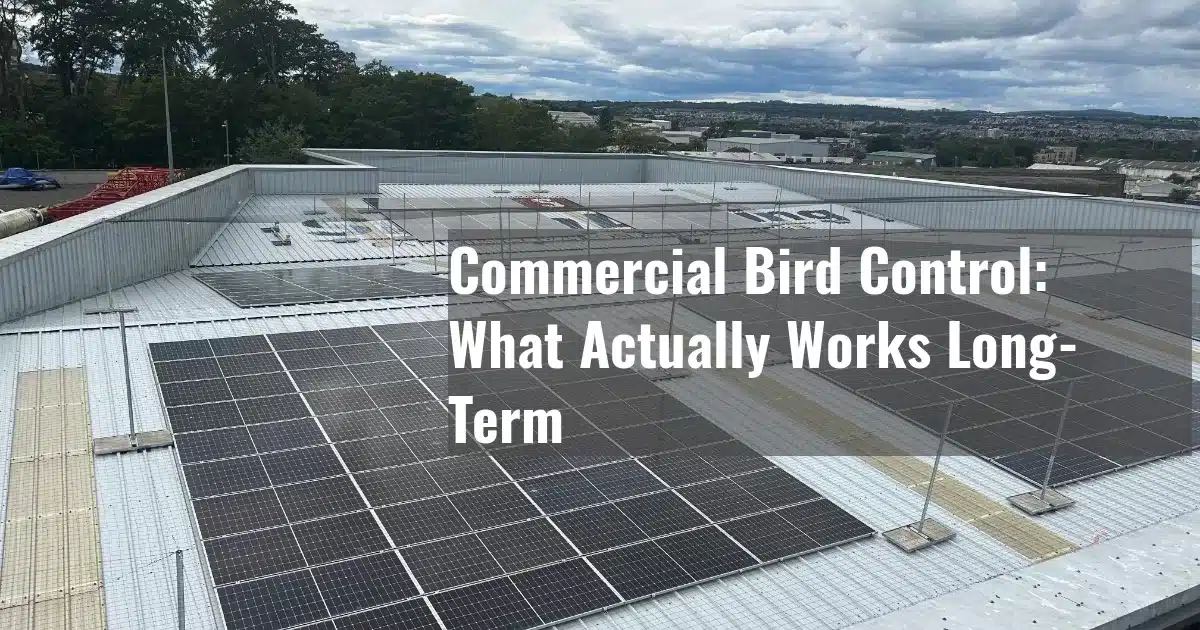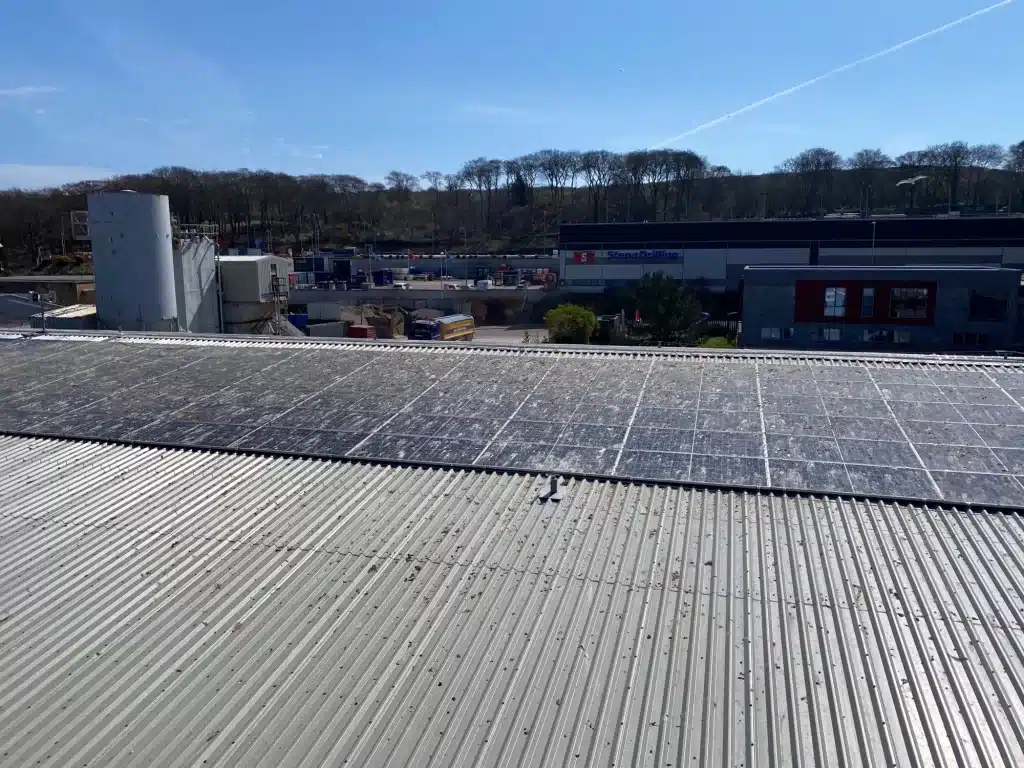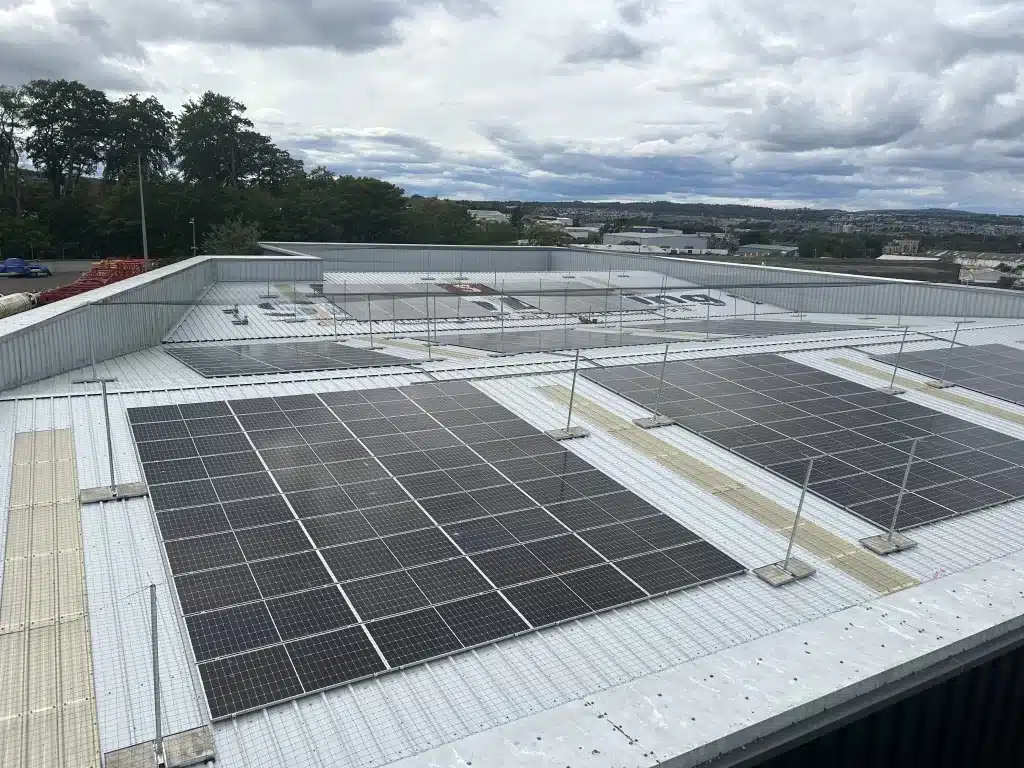
Gulls destroying your solar panels? Here’s what actually works for commercial bird control in Scotland—real results, honest costs, proven methods and a client review.
Table of Contents
What no one tells you about birds on commercial property…
You’ve invested in solar panels—a smart move for cutting costs and reducing your carbon footprint. They’re working well, generating clean energy. Then the birds arrive. Typically, but not exclusively—gulls or pigeons.
Three months later, your panels are covered in bird mess. The output’s dropped by 30%. Your car park looks like a Pablo Picasso painting. You’re paying someone to power-wash the same surfaces every other week.
This isn’t a hypothetical. We saw exactly this at Stena Drilling’s Aberdeen site—office buildings, warehouse, and all outdoor areas. Their solar panels were practically non-functional under the mess. Every car in the car park was affected. The cleaning costs were mounting up, and the whole point of having solar panels—the productivity, the savings—was being completely undermined by birds that had decided this was their new favourite spot.
So what actually works when birds have made your property their home? More importantly, what actually works long-term versus what’s just a short-term fix that wastes your money?
Here’s what we’ve learned from sorting this out dozens of times across Scotland.
The Real Bird Control Problem (And Why “Just Scare Them Away” Doesn’t Work)
What’s important to understand about birds on commercial property is this: They’re not there by accident.
If you’ve got gulls roosting on your building anywhere in Scotland, they’ve chosen that spot deliberately. Protected from wind. Good view of the area. Close to food sources. Safe from predators. That ledge you’re annoyed about? That’s a prime site for a gull.
Trying to scare them away with those reflective strips or fake owls? It works for about a week. Maybe. Gulls are smart—far more intelligent than people realise. They’ll ignore that plastic hawk within days. We’ve seen it happen.
Pigeons are even worse for adapting. Put up something shiny that moves in the wind, and they’ll treat it like garden decoration after the first few days. They’re urban birds. They’ve evolved alongside humans. A bit of sparkle isn’t putting them off their favourite nesting spot.
Crows are incredibly intelligent. They’re so smart they’ll sometimes deliberately test deterrents to see if they’re actually dangerous. If your visual deterrent doesn’t actively hurt them (and it shouldn’t, obviously), they’ll soon realise it poses no actual threat.
What actually matters is this: physical exclusion. If birds can’t physically land or nest somewhere, they can’t make it their territory. Everything else is just varying degrees of temporary.
What’s Actually Working Right Now
Physical Barriers (The Stuff That Lasts)
Netting
This is your heavy-duty solution. We’re talking properly installed bird netting that creates a complete barrier over the area you’re protecting.
At Stena Drilling, we netted both the office roof and warehouse roof where the solar panels were installed. The difference was immediate—we mean immediate. The panels went from being covered in mess to actually functioning properly again. Their electricity output jumped. The constant cleaning stopped being necessary.
What matters most is this: netting needs to be installed correctly. Outside breeding season (that’s April to July for gulls in Scotland—you can’t touch active nests, it’s illegal). Properly tensioned. No gaps. If there’s a gap big enough for a tennis ball, a pigeon will find it.
Cost-wise, you’re looking at £2-8 per square metre depending on the site and access. It sounds like a lot until you work out what you’re spending on cleaning. Or what your solar panels should be generating but aren’t. Or what bird mess is doing to the metalwork over time.
The lifespan is 5-10 years if it’s installed properly. That’s not a recurring cost every year.
Spikes
These look aggressive. They’re not—birds just can’t land on them, so they don’t bother trying.
After sorting the solar panels at Stena Drilling, we added spikes to the main flat roofs to prevent more gulls landing. Did it totally eradicate the problem? No, and their testimonial’s honest about that. The reduction was “hugely noticed by everyone”—fewer birds on cars, less mess, and a better working environment overall.
Spikes work brilliantly on ledges, window sills, and anywhere birds like to perch. They’re discrete, require low maintenance, and they last 8-15 years.
You’re paying £3-15 per linear metre. For a typical commercial building with problem ledges, that might be £200-500 total. Compare that to weekly cleaning costs.
Wire Systems
These are for narrower surfaces—signage, pipes, that kind of thing. They’re less visible than spikes and almost as effective. When a bird lands, the wire’s unstable, so they leave.
They’re good for sites where aesthetics matter but you’ve still got a bird problem.
Visual and Sonic Deterrents (The Supporting Cast)
From experience, visual deterrents on their own aren’t worth it for commercial sites with established bird problems.
However—and this is important—they work as part of a bigger strategy.
If you’ve installed physical barriers on the main problem areas, adding some reflective deterrents or decoys to secondary spots can help. The birds are already being pushed away from their preferred locations by the netting or spikes. A few reflective strips in less critical areas might tip the balance and send them somewhere else entirely.
Sonic systems are similar. They can be effective in large open areas—loading bays, car parks, that kind of space. They’re not magic, though. You need to vary the sounds. Move the units periodically. You’re spending £200-800 per unit.
For most commercial sites, we’d recommend sorting the physical barriers first. Then assess whether you need sonic backup.
The Species You’re Actually Dealing With
Not all birds cause the same problems. Knowing which species you’ve got helps.
Gulls
These are the big problem in coastal areas and increasingly inland locations. They’re aggressive, intelligent, and protected during breeding season. They’ll nest on flat roofs given half a chance, and once they’ve nested somewhere, they come back every year.
If you’ve got gulls, you need serious barriers. Netting. Spikes on every flat surface. They’re persistent enough that half-measures won’t cut it.
Pigeons
Urban pigeons have zero fear of humans. They adapt to almost anything. The heavy roosting damage is significant—their mess is acidic, and it corrodes metalwork and stonework over time.
The good news is they respond well to physical barriers. Spikes on ledges, netting over larger areas. Once they can’t physically access their preferred spots, they move on.
Starlings and Crows
These are intelligent flock birds. Crows in particular will test deterrents to see if they’re real threats.
Sonic deterrents with varied patterns can work here. You need to move them regularly—every 3-5 days—or the birds work out they’re not actually dangerous.
House Sparrows
These are small, cavity nesters. They’re the ones getting into roof spaces and behind fascias.
Fine mesh netting works well for them. Exclusion of entry points. Multiple small interventions rather than one big deterrent.
What It Actually Costs (And What You’re Saving)
Please note: All prices quoted in this article are indicative examples only. Actual costs vary significantly based on property size, access requirements, bird species, and severity of infestation. All installations are subject to a free site survey and formal quotation.
Here’s a breakdown of typical costs.
Small Commercial Properties (£500-1,000 investment)
Typical approach:
- Spikes on main ledges: £150-300
- Netting over problem area: £200-400
- Basic visual deterrents: £50-100
What you’re preventing:
- Weekly cleaning: £100-200/month = £1,200-2,400/year
- Minor repairs to metalwork: £200-500/year
- Potential health and safety issues: Priceless when you avoid them
That’s paid back in 6-12 months.
Medium Commercial Sites (£1,500-3,000)
Typical approach:
- Netting for solar panels or key areas: £800-1,500
- Spikes on multiple roofs: £400-800
- Additional barriers: £300-700
What you could gain:
- Solar panels working at full capacity
- Elimination of repeated cleaning costs
- Reduced long-term equipment damage
- Improved working environment
- Better use of outdoor spaces
This level of investment typically pays for itself within 12-18 months.
Large Industrial Sites (£3,000-6,000+)
Comprehensive solutions:
- Multiple netting installations: £1,500-3,000
- Extensive spike and wire systems: £1,000-2,000
- Professional sonic systems: £1,000-2,000
Preventing:
- Major cleaning contracts: £5,000-10,000/year
- Equipment damage and contamination
- Productivity losses
- Health and safety violations
This pays for itself quickly. It’s especially true if you’re in food processing, manufacturing with sensitive equipment, or anywhere hygiene matters.
When to Do This (Timing Matters)
Spring (March-May)
This is when you need to get it done, before breeding season starts. Once birds have nested, you can’t touch them legally under UK law.
This is your window for proactive work. Birds are establishing territories, so if you install barriers now, they’ll find somewhere else to nest.
Summer (June-August)
You’re stuck if there are active nests. You can work on areas without nesting, but your options are limited.
If you’ve got gulls nesting and causing problems—and you haven’t sorted barriers beforehand—you’re basically waiting until the chicks fledge. That’s usually August.
Use this time to plan for autumn installations.
Autumn (September-November)
This is perfect timing. Birds are looking for winter roosts, and the weather’s still decent for installation work. Get it done before winter, and you’re sorted for the next nesting season.
At Stena Drilling, we did the work outside the breeding season specifically, which was both ethical and legal.
Winter (December-February)
This is a good time for maintenance and planning. You can inspect existing barriers, plan where you need additional protection, and birds are more concentrated in fewer areas, which makes it easier to spot the problem zones.
The Aberdeen Case Study (What Actually Happened)


Let’s analyse the Stena Drilling job in detail because it shows what works in real conditions.
The Problem:
Solar panels on office and warehouse roofs. Gull mess everywhere. The panels were generating maybe 70% of what they should have been. The car park was covered in droppings. Weekly cleaning was expensive and didn’t solve anything long-term.
What We Did:
We installed netting over both roofs where the panels were installed. We did it outside breeding season—no active nests, no legal issues, no ethics problems.
Then, after monitoring how that worked, we added spikes to the main flat roofs to prevent more birds landing.
The Results:
There was an immediate difference in panel cleanliness. Electricity output jumped—”huge increase in productivity” is how they described it. It stopped the constant need for cleaning. It reduced long-term damage risk to the actual panels.
The car park situation massively improved. Not totally solved—they’re honest about that—but “the difference is hugely noticed by everyone.”
Investment Details:
The Stena Drilling installation was a comprehensive commercial solution covering multiple roofs, extensive netting systems, and additional spike installations. The total investment reflected the scale and complexity of protecting a multi-building industrial site with sensitive solar panel installations across both office and warehouse facilities.
Client Testimonial:
“After the solar panels were installed, we quickly noticed how messy they were getting with bird mess coverage which then pushed us to install the bird netting to protect the panels on both our office roof & warehouse roof as this is where the panels were installed. Once these nets were installed, we noticed just as quickly how differently the panels were performing, the nets have also prevented excess cleaning which was costly. After closely monitoring the situation, we decided then to put more nets onto some of the main building flat roofs along with spikes to further prevent nesting & gulls landing. Although this hasn’t totally eradicated this issue, the difference is hugely noticed by everyone with the reduction of bird mess on everyone’s cars.”
What This Tells You:
Physical barriers work. The right installation, in the right places, gives you immediate and lasting results. You might need to add secondary barriers later (like they did with the spikes) as you see where birds are still landing. Once the main problem areas are protected, you’re in control of the situation.
The key point is this: the solar panels were the reason for the installation, but the whole site benefited. Cleaner buildings. Better car park. More pleasant working environment. The return wasn’t just in electricity generation—it was across the whole property.
Legal Stuff You Need to Know (Scotland)
This is important because UK law protects most wild birds, and the penalties for getting it wrong are significant.
Gulls are protected under the Wildlife and Countryside Act. You can install deterrents, but you cannot disturb active nests during the breeding season, which typically runs from March to August.
Any bird with active nests needs to be left alone until the chicks have fledged. The fines for nest destruction are substantial, and ignorance isn’t a defence.
How to stay legal:
- Install barriers outside breeding season
- If you’ve got active nests, get professional advice before doing anything
- Document everything—photos of the problem, when you installed barriers, all of it
We make sure everything we do is legal and ethical. The Stena Drilling installation was specifically timed outside breeding season, with no shortcuts and no issues.
Should You Try DIY Bird Control?
It depends on what we’re talking about.
DIY Works For:
- Small residential properties
- Limited problem areas
- Pigeons on accessible ledges
- Budget under £200
If you’re in this category, you can buy some spikes, install them yourself, add reflective tape, and it might solve the problem.
Get Professionals For:
- Commercial properties
- Solar panel protection
- Any work above single-storey height
- Gulls or protected species
- Anything during or near breeding season
- Systems that need to last years
The Stena Drilling job needed proper netting installation. Warehouse roofs. Multiple buildings. It wasn’t a DIY situation. They tried managing it with cleaning initially. It didn’t work. The professional installation solved it properly.
We’ve seen people spend £500 on DIY attempts spread over a year, then call us anyway. That’s £500 gone plus the cost of doing it right. It’s better to get it sorted properly the first time.
What You Should Actually Do
If you’re dealing with bird problems on commercial property, here’s the sensible approach:
Step 1: Work out what birds you’ve got
Are they gulls or pigeons? The species makes a difference to the solution, so take photos if you’re not sure.
Step 2: Identify where they’re landing and roosting
Focus on where the birds are actually perching and nesting, not just where you see the mess afterwards. Those are the areas that need protection.
Step 3: Check the calendar
If it’s March to July and you see active nests, you’ll need to wait and plan for post-breeding season. If it’s August to February, you can act now.
Step 4: Get a proper assessment
We’ll come out, look at the actual problem, and tell you what’ll work and what won’t. There’s no point putting spikes somewhere that needs netting. There’s no point putting netting where spikes would do the job for a third of the cost.
Step 5: Install it properly
Whether that’s us doing it or someone else, it needs to be installed correctly. Gaps in netting mean birds getting through, and poorly installed spikes mean birds landing anyway.
The Stena Drilling installation worked because we did it properly with the right materials, correct installation techniques, and appropriate timing.
The Bottom Line
Bird problems on commercial property don’t fix themselves. They get worse.
More birds. More mess. More damage. Higher cleaning costs. Equipment that doesn’t work properly—like solar panels covered in gull mess. Eventually, health and safety issues.
Physical barriers work. They’re not cheap initially, but they last. They solve the problem properly instead of managing it temporarily.
At Stena Drilling, the netting and spikes transformed the site. Solar panels actually producing what they should. Car park usable. Buildings cleaner. Better environment.
That’s what proper bird control does. It fixes the problem and then you’re done with it.
If you’re in Perth, Dundee, Fife, Aberdeen, or anywhere across Central Scotland and you’re dealing with birds on commercial property—especially if you’ve tried the cheap fixes and they haven’t worked—we can help.
We’ll assess what you’ve actually got, tell you what’ll work for your site, and install it properly. Outside breeding season, legally sound, methods that don’t harm the birds but get them off your property.
No sales pitch. Just practical advice from people who’ve done this dozens of times and know what actually works versus what sounds good but doesn’t.
Strathearn Pest Control Services
At Strathearn Pest Control, we understand the unique challenges faced by commercial property owners dealing with bird infestations. Our team of experienced professionals offers tailored solutions for bird control, helping you protect your property and equipment while minimising environmental impact.
Our bird control services include:
- Comprehensive site assessments and bird species identification
- Customised bird control plans for your specific situation
- Professional installation of netting, spikes, and wire systems
- Eco-friendly and humane control methods
- Legal compliance guidance for protected species
- Ongoing support and maintenance
Strathearn Pest Control – Bird control that actually lasts. Based in Perthshire, working across Scotland. Contact us today for a free site assessment.
FAQs
Are bird control methods safe for the birds?
At Strathearn Pest Control, we prioritise the use of humane bird control methods that deter birds without causing them harm. Our techniques are designed to encourage birds to find alternative locations while minimising any potential distress or injury. All our methods comply with Scottish wildlife protection laws and focus on exclusion rather than harm.
How do I know which bird species I’m dealing with?
Proper identification is crucial for effective control. Pigeons are grey with iridescent necks and are most common in urban areas. Gulls are larger white/grey birds often found near coastal areas but increasingly common inland. Starlings are smaller, darker birds with yellow beaks that often travel in large flocks. If you’re unsure, take photos and contact Strathearn Pest Control for professional identification and targeted solutions.
What should I do if birds are already nesting on my property?
Never disturb active nests without checking legal requirements first. Many bird species are protected during breeding season (typically March-August), and disturbing nests can result in significant fines. Contact Strathearn Pest Control immediately for guidance on legal options and post-breeding prevention strategies. We can help you plan effective control measures that comply with all regulations.
How long does it take for bird control measures to be effective?
Effectiveness timelines vary by method. Physical barriers provide immediate results as birds physically cannot access the area. Sonic deterrents typically take 1-2 weeks for birds to learn to avoid the area. Visual deterrents work within 3-7 days initially but require regular repositioning to maintain effectiveness. Combination methods are often most effective within the first week when properly implemented.
How much will bird control cost for my property?
Costs vary significantly based on property size, bird species, severity of infestation, and methods required. Small residential jobs might cost £200-500, while comprehensive commercial solutions can range from £1,000-5,000+. We provide free assessments and detailed quotes with no obligation. Most customers find that professional bird control pays for itself within the first year through prevented damage and maintenance costs.
Can bird control methods affect other wildlife or my pets?
Well-designed bird control should be species-specific and professionally installed. However, poorly installed netting can occasionally trap small mammals, and some sonic devices may affect pets with sensitive hearing. Strathearn Pest Control designs all systems to minimise impact on non-target species while maintaining effectiveness against problem birds.
For more information on our bird control services or to schedule a consultation, contact us today. Our friendly and knowledgeable staff is ready to assist you in finding the best solution for your bird control needs.

